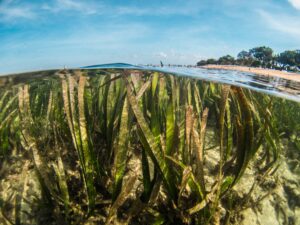Sunscreen chemicals found in Mediterranean seagrass
A new study has found that Posidonia oceanica is absorbing UV filters, potentially damaging fragile ecosystems.
With southern Europe preparing for its first fully open summer after two years of travel restrictions and lockdowns, many destinations on the Mediterranean Sea are hoping for significant tourism footfall over the coming months.
However, researchers conducting an investigation into marine life off the coast of Mallorca, Spain, may have found evidence that sunbathers and swimmers are inadvertently causing harm to the local environment.
UV filters found in sunscreen lotions have been detected in the stems of Posidonia oceanica seagrass, which grows into large meadows considered essential for a healthy environment, providing a home to numerous species, helping store CO2, and protecting coastlines from extreme erosion. It is therefore believed the chemicals could damage fragile ecosystems, with evidence showing the reproductive systems of fish, turtles and dolphins can be effected.
Varying concentrations of oxybenzone, avobenzone 4-methyl, benzylidene camphor, benzophenone-4 and methyl parabens have been found in the seagrass, the effect of which is currently unclear. Nevertheless, destinations like Hawaii, Palau and Florida already have bans on these chemicals over fear of the environmental impact.
‘If we find that sunscreens affect the photosynthesis and productivity of seagrasses beyond accumulation, we will have a problem since these seagrasses play important ecological roles in the Mediterranean coasts,’ said Prof Nona Agawin, co-author of the work, which was published in Marine Pollution Bulletin.
‘This marine enclave is impacted by port activities, water discharge and tourism,” added co-author Dr Silvia Díaz Cruz. ‘Since the Mediterranean Sea is shallow, small and very enclosed, concentrations of UV-absorbing chemicals can reach high [levels].’
In related news, plastic pollution in the Arctic Ocean is now believed to be comparable to many densely populated areas of the globe.
Image credit: Benjamin L. Jones
















